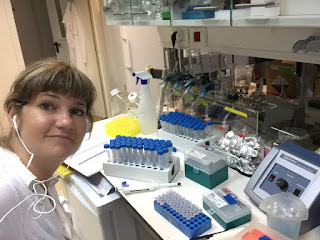But, oh dear, no. There is also plenty of work to be done.
My coral experiment came to an end with a total of 95 coral fragments sampled. A fair amount for a full month of experiment. But also a fair amount considering the time it will take to prepare all the samples for analysis.
So now it's time for some lab work.
So I went to Ben Gurion University of the Negev Sede Boqer where there is a large department for research on water resources and where my collaborator Edo Bar-Zeev is working.
That ended up being 4 days of intense lab work.
A lot of people probably don't realize of much work there can be for doing one specific analysis (and why would you know if you've never done it?!).
For example, I am analyzing the protein content in my corals. The analysis it self is easy enough: You make a standard curve of know protein concentrations you get from a kit, add some specific solvent that reacts with proteins and a machine reads the output.
The preparation though.. First your sample needs to be diluted into pre-made solution. Unless your sample is still in liquid, then you'll need to centrifuge it for at least 20 min so the cell material sinks to the bottom and you can discard the liquid.
Then you need to break the small cells so the kinetic analysis solvent can react with the proteins inside the cells. To do this you need to sonicate the sample (burst it with ultrasound waves. Sounds like the dentist from hell) for 1.5 min, but in intervals of 30 sec so you don't heat up the sample. Then you need to centrifuge again.
Now you are ready to prepare the plate of samples that goes into the analytic machine. That means pipetting 10 µL of the sample into a tiny well on a plate. That's the size of a small drop. Then add the kinetic solvent but as fast as possible to all of the samples so they will have the same reaction time.
So time this up with 95 samples and you have a full days work! The sonication alone is almost 3 hours and with the pipetting and centrifuging its well after lunch time when you're ready to read your samples on the machine.
The read it self is only 2 min which makes the 5 hours of preparation seem even more intense.
 |
| Sonicating 95 samples |
The last lab marathon happened last week. Trying to get a big bunch of samples prepped and analyzed before heading back to Santa Cruz. It ended with two intense lab days: First day to finish the last of the protein analyses (this time only 12 samples - phew!) and calibrate the instrument for our bacteria and plankton analysis. The second day I started at 7:30am labeling vials. We thawed half of the samples we had and started prepping them. At 4pm we could run the first analysis. At 7pm we started the second. At midnight, the third and last. At 4am I shut down the machine and went to bed.
A nice 20 hour work day. I won't even try to explain how hard a day like that is. It won't do it justice. Once samples are thawed there is no turning back. So take home message: Don't thaw too many samples at a time!
The bright side is: We have data! Now "all" there is left is to look through the data and make sense of it.
And I will probably return to Sde Boker sometime in Winter to finish the last half of my samples in the freezer..





















































